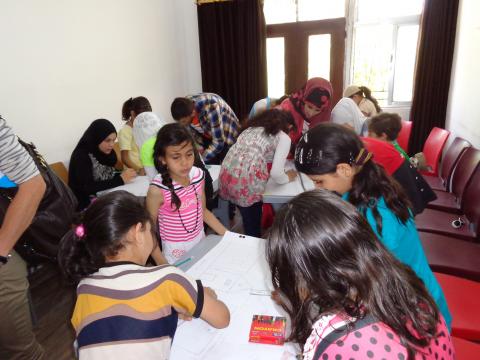Bringing children together in Jordan

In a small building tucked into a back street in downtown Irbid, Jordan, World Vision is helping to bridge the gap between Syrian refugee children and vulnerable kids in Jordan.
It’s a sunny Monday morning in the northern Jordanian city of Irbid, located just 15 kilometres from the Syrian border. At a community centre in the downtown core, a group of children are drawing maps that feature scenes of their neighbourhood, while in another room, younger children delight in playing with toys and putting magnetic letters up onto a small blackboard under the watchful eye of a social worker.
This could be a typical scene at a day care centre in almost any part of the world. But here in Jordan, where the conflict in Syria has brought more than 600,000 refugees into the country, the youngsters taking part in these activities represent an effort by World Vision to help bring together children from two very different realities. At this Child-friendly Space (CFS), Syrian refugee children play, laugh and learn together with Jordanian kids from the local community.
The day care centre is a place where children from Syria and Jordan can play together, and learn more about each other.
The program is operated by World Vision and its local partner, the Family/Childhood Protection Society of Irbid. Funded by the Government of Canada, the CFS operates six days per week and serves approximately 200 children from both sides of the border. About 70 percent of the children taking part are Syrian refugees, while the remaining 30 percent are Jordanian.
The Society’s executive director, Fadi Dawagreh, says the joint program has been operating since March and there have been few problems in mixing the two groups of children. He points out that some of the younger Syrian refugees have been in Jordan for up to three years already, and have only limited memories of their homeland.
The situation for older refugee children can be more difficult, and Dawagreh says many of these kids prefer to come to the CFS, rather than to go to local schools, because they don’t feel intimidated by their lack of knowledge of the Jordanian curriculum. For those who are facing more serious psychological problems, the Society’s staff has received training to identify symptoms of potential illness and to refer the children to appropriate agencies for help.
Looking at the children laughing and playing together, it’s virtually impossible to tell the Syrian and Jordanian children apart. Dawagreh says his group has worked hard to include vulnerable Jordanian children, as well as their Syrian counterparts, to help ease tensions in the local community. As the number of Syrian refugees in Jordan has risen dramatically since 2011, pressures have been building in host communities as competition for housing, medical care and school space continue to grow.
As for the future, the current group of children will be able to take advantage of the facilities and services of the CFS in Irbid until late July, when a new group of 200 Jordanian and Syrian children will take their places. This helps maximise the number of vulnerable children who receive support, and it’s hoped that more Jordanian and Syrian children can be brought into similar programs at World Vision CFSs in other host communities in Jordan.